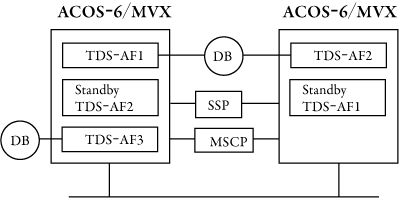NEC announced ACOS-6/MVX (Multiple Virtual eXtended) in September 1984, and started shipping it in March 1985.
ACOS-6/MVX was an operating system for large to ultra-large machines,and was designed to have high functionality, expandability and reliability while maintaining upper compatibility based on a concept consistent with the operating system ACOS-6, which was shipped earlier.Compared with ACOS6 it achieved a higher level of basic system control, such as support for large-scale, high-performance multiprocessor systems and support for virtual computer systems, and realized a basic software extension function that integrated a mainframe supporting integrated office automation with workstations. ACOS-6/MVX was installed in systems 650, 850 and 1000, which had previously operated with ACOS-6, as an upper compatible OS, as well as in systems 830, 930 and 2000, which were newly shipped.
Features of the newly adopted architecture and of major functions included the following:
1. Features of the Architecture
(1) A closely coupled multiprocessor system and a loosely coupled multiprocessor system
There were two types of multiprocessor systems: a tightly coupled multiprocessor system in which multiple processors were coupled via the main storage under the control of a single OS, and a loosely coupled multiprocessor system in which multiple processors under control of multiple OSs were coupled via a file storage.
For tightly coupled multiprocessor systems, ACOS-6/MVX allowed a system consisting of up to four processors to be built, as
ACOS-6 which was shipped earlier. For loosely coupled multiprocessor systems,
ACOS-6 supported a file-exclusive loosely coupled system SMS (Shared Mass Store), which performed sharing-exclusion control in files. However, ACOS-6/MVX lowered the level of exclusive control from files to blocks in a file, and adopted the multisystem controller MSCP (Multi System Control Processor), which performed lock control and deadlock control between multiple OSs at high speed and with high reliability, in order to increase the simultaneous running performance if a database were shared among multiple OSs. This block-exclusive loosely coupled system was called SMS-AF (Shared Mass Store-Advanced Functions).
 Figure 1
Figure 1
(2) Hot-standby type fault-tolerant system
The OS enabled establishment of a fault-tolerant system that instantaneously continued online operation while performing rollback recovery of a database using a standby host computer and its operating system in the event of stoppage of an operating host computer or its operating system due to a fault, by incorporating a hot-standby mechanism on an online database and online transaction system TDS-AF, in a loosely coupled system SMS and an SMS-AF system in which multiple host computers shared a file storage that stored a database system.
 Figure 2
Figure 2(3) Virtual computer system
NEC provided a virtual computer system, VMX (Virtual Machine eXtended), which generated multiple virtual computers on a single host computer in response to the demand for development of a new business operation or version-upgrade without affecting the current business operation, on
systems 2000 and
930, at a time when computerization of business operations was becoming widespread. VMX consisted of a parent OS that operated directly on the host computer, a virtual computer monitor that ran a job one level above the parent OS, one or more virtual computers simulated under control of the virtual computer monitor, and child OSs operating on the virtual computers. The parent OS was capable of operating without being affected by the overhead of the virtual computer monitor, and the workload on the parent OS and that on the child OSs could be separated from each other according to the resource allocation specified on the virtual computer monitor.
 Figure 3
Figure 32. Features of the Functions
(1) Integrated application software
The OS realized an integrated office system that integrated data processing using a host computer with business automation for the end user, such as office automation. In addition, it enabled various forms of information processing that were familiar to people, such as Japanese-language documents, diagrams and images, based on the Japanese-language information processing system JIPS as a function to support the integrated office system.
(2) Integrated online database
In addition to the network-type database ADBS (Advanced Data Base System), which was supported by
ACOS-6, the OS provided relational databases RIQS (Relational Information Query System) and INQ. Use of a high-performance, high-reliability transaction processing system TDS-AF enabled an advanced online database to be built on these relational databases.
(3) Programming language for artificial intelligence
The OS supported high-level languages LISP and Prolog for artificial intelligence.
(4) Automation and laborsaving system operation
The OS supported detailed operation control of the power-on and power-off times of the system and its peripherals through linkage with the automatic operation controller AOC , by strengthening the descriptive language AOL of the operation logic with the automatic operation system AOS, in response to the demand for automation and labor-saving system operation. In addition, the OS supported system operation/maintenance work in the computer operation department by providing the operation management systems FIPS・AD.
(5) User management
With a user management function UAF-AF (User Administration Facility - Advanced Function), the OS provided management and authorization of layered users, restrictions on resource allocation by user groups and available commands and applications, and checking of authority for data access, in order to support operation of the host computer in work groups.




